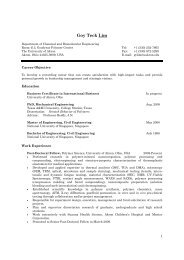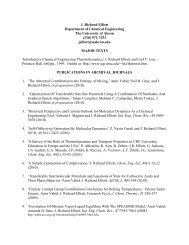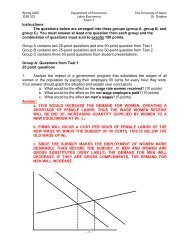Sociology of the Anarchists - Gozips.uakron.edu - The University of ...
Sociology of the Anarchists - Gozips.uakron.edu - The University of ...
Sociology of the Anarchists - Gozips.uakron.edu - The University of ...
Create successful ePaper yourself
Turn your PDF publications into a flip-book with our unique Google optimized e-Paper software.
Individual anarchists also have quite a swaying power, an influence that approaches<br />
charismatic authority, but still falls short – partially due to a general repulsion <strong>of</strong><br />
leadership and partially due to a rejection by <strong>the</strong>se individuals <strong>of</strong> being used as idols.<br />
Noam Chomsky is a very influential individual to many activists on <strong>the</strong> political Left,<br />
Murray Bookchin is a political force in <strong>the</strong> New England states with his <strong>the</strong>ories <strong>of</strong> social<br />
ecology and libertarian municipalism, and John Zerzan is greatly admired in <strong>the</strong> Pacific-<br />
Northwest for his writings about primitivism. Thus, it is an anarchist “norm” to read <strong>the</strong>se<br />
charismatic writers, but not necessarily to be compelled to agree with all <strong>the</strong>y write or<br />
advocate. 48<br />
<strong>The</strong> only sense in which Weberian authority might intersect with anarchism is with legalrational.<br />
Although anarchists oppose <strong>the</strong> hierarchically-ordered modern state, <strong>the</strong>y do<br />
practice a form <strong>of</strong> legal-rational authority within small organizations. In collectives, for<br />
instance, <strong>the</strong>re are <strong>of</strong>ten rules or guidelines that must be followed, or else sanctions are<br />
lobbied. This is a voluntary reverence to authority, though, since any member <strong>of</strong> <strong>the</strong><br />
collective can leave at any point. Also, it differs from most o<strong>the</strong>r forms <strong>of</strong> legal-rational<br />
authority in that individuals make a conscious effort to accept <strong>the</strong>se rules, or even are<br />
involved in <strong>the</strong> rule formation <strong>the</strong>mselves.<br />
Even though it seems plausible to place some anarchist organizational structures within<br />
<strong>the</strong> legal-rational framework, Weber’s work suggests o<strong>the</strong>rwise. He writes that although<br />
“legal rule” can be found in voluntary associations (such as anarchist collectives), it needs<br />
“an extensive and hierarchically organized staff <strong>of</strong> functionaries” (Weber 1958, p. 2).<br />
Since <strong>the</strong>re is no hierarchy present in a collective, nor permanent functionaries, Weber’s<br />
own criteria discounts this possibility.<br />
Yet, as Spencer points out, <strong>the</strong>re is a difference between Weber’s legal-rational authority<br />
and an under-discussed fourth type, value-rational authority. <strong>The</strong> latter is “subordination<br />
to a principle” (Spencer 1970, n. 2). In this respect, anarchist frequently submit to valuerational<br />
authority, such as in consensus decision-making processes; decisions are made<br />
through a formalized process and assisted by one <strong>of</strong> more facilitators who are empowered<br />
to help <strong>the</strong> group reach a shared decision, but also enforce <strong>the</strong> rules <strong>of</strong> consensus. Thus,<br />
anarchists submit to <strong>the</strong> authority <strong>of</strong> <strong>the</strong> values <strong>of</strong> consensus and direct democracy, but<br />
not necessarily <strong>the</strong> legality <strong>of</strong> it.<br />
Near-Modern North American Anarchist Movement History<br />
Apter's (1970) account is typical <strong>of</strong> <strong>the</strong> general confusion <strong>of</strong> 1960s youth counter-culture<br />
movement with anarchism. <strong>The</strong> term “anarchism”, clearly, has been used inaccurately by<br />
opponents and those supposedly in favor <strong>of</strong> “anarchism”. He conflates anarchism with a<br />
type <strong>of</strong> self-destructive, psychologically-ridden ideology, practiced by <strong>the</strong> non-<strong>the</strong>oretical,<br />
and generally foolhardy. He makes connections with this counter-culture and past<br />
48 Yet, it is still <strong>the</strong> case that anarchists, especially American anarchists (and feminists), incorporate <strong>the</strong><br />
name and likeness <strong>of</strong> “Emma” (as in Emma Goldman) into <strong>the</strong>ir projects, infoshops, punk bands, tshirts,<br />
speeches, propaganda, artwork, etc.<br />
[ Williams 53 ] [ this is a draft. do not cite. ]






